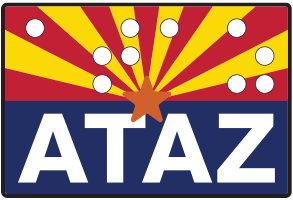Overview PDF version 295kb, 2 pages
AT AZ is a project to support Disability Awareness and related Assistive Technology as a tool to support employment for persons with disabilities.
Scope
The scope of this project includes Disability and Assistive Technology Awareness as follows:
- Face to face and web-based training for state staff, contractors and employers
- Disability Resource Listings and Overview Information
- Local and national Assistive Technology Resource Listings
- Accommodation listings with practical training for state staff and other partners of the Arizona@Work network ATarizona.com website to support all efforts listed above
What is Assistive Technology?
“Assistive Technology”, or “AT” is the term we use to describe equipment/services/strategies used by persons with disabilities to access tasks, equipment and/or places in the environment that are otherwise inaccessible. Assistive Technology includes a full range of solutions such as:
- “low tech” supports like Velcro, stickers, reading or writing guides
- “light tech” supports: digital recorders and mobile devices
- “high tech” supports: adaptive software products, refreshable Braille, high tech wheelchairs and environmental control devices.
Federal Definitions of Assistive Technology:
- “Assistive Technology Device” is defined as “any item, piece of equipment, or product system whether acquired commercially off the shelf, modified or customized, that is used to increase, maintain, or improve functional capabilities of individuals with disabilities.”
- “Assistive Technology Service” means any service that directly assists an individual with a disability in the selection, acquisition, or use of an assistive technology device.
Disability Awareness Workshops
Listed below are the workshop categories, workshop title, and description.
All Category Introduction to Assistive Technology Arizona
This session identifies competencies staff should have to establish rapport, improve communication, and use available AT accommodations within their workplace.
General Category Disability and Civil Rights
Learn general disability information, including disability and employment, the Rehab Act, IDEA, ADA, GINA, and AT etiquette.
Vision Category Blind and Visually Impaired (“BVI”)
Learn about different types of vision loss, appropriate communication, basic guidelines for working with a client, and available AT.
Hearing Category Deaf and Hard of Hearing (“DHH”)
Learn about different types of hearing loss, Deaf culture, appropriate communication, hearing aids and available AT.
DeafBlind Category Combined Vision and Hearing Loss (“CVHL”)
Learn about combined vision and hearing loss, related challenges and AT adaptations, and the resources available to you. This session gives an overview of how to work with a person in this population, including communication and guiding tips.
Physical Category Mobility Disabilities and Ergonomics
Learn the scope of the word “Ergonomics” and understand how it influences accessibility and physical access accommodations in the workplace.
CognitionCategory Cognitive Disabilities
Learn about cognitive challenges such as learning disabilities, cognitive/developmental disabilities, traumatic brain injuries (TBI), and mental health. This session also reviews related AT and workplace accommodations.
Speech Category Augmentative and Alternative Communication (“AAC”)
Learn what AAC is, who uses it, why it is valuable, and what technology is available. This session also discusses the importance of a team approach, and how to navigate funding.
Other Category Episodic Disabilities
Learn what is considered an episodic disability and how they affect the use of AT and workplace accommodations.
Frequently Asked Questions (FAQ)
FAQ Frequently Asked Questions Who uses Assistive Technology?
Any person who has a disability that interferes with their ability to communicate, learn, move, engage with others, or otherwise participate in regular life activities would benefit from A.T.
FAQ Frequently Asked Questions Why is Assistive Technology important?
A.T. helps people with disabilities be active, healthy, and engaged members of their community. In a work environment, A.T. gives people with disabilities the opportunity to be as efficient and effective as possible, and to fully participate in work culture. In addition, studies have shown that disability diversity in the workplace increases productivity. Source: Disability in the workplace: Embracing disability diversity
FAQ Frequently Asked Questions How do I learn which Assistive Technology is best for myself, my client, or my employee?
If you are an employer, the first place to start would be to talk to your employee to see what they think would be the most helpful. The Job Accommodation Network (askjan.org) is a great resource for any accommodation related questions. You can browse their website, or contact a representative for specific recommendations. You can also attend one of our trainings in the category applicable to you, or browse the web to find recommendations from people with similar disabilities. Great sources of information can be found in each category under our “Resources” page.
FAQ Frequently Asked Questions Is assistive technology expensive?
Assistive technology can be very expensive, but it can also be cheap or even free. It will vary depending on the need the A.T. is trying to meet and the sophistication of the chosen technology. One survey found that 56% of workplace accommodations did not cost any money. The remaining cases cost about $500. If you, an employee, or a client are interested in trying a piece of equipment before you purchase it, the Arizona Technology Access Program (aztap.org) is a great resource to borrow products. Average Costs of Reasonable Accommodations in The Workplace
 ATArizona.com
ATArizona.com 